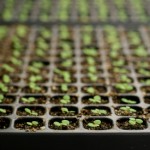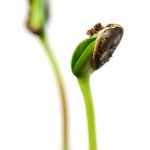 I’m in hibernation mode with visions of seedlings dancing in my head.
I’m in hibernation mode with visions of seedlings dancing in my head.
The fact that I start receiving all kinds of catalogs with gorgeous flowers and healthy vegetables only encourages me. Thus begins my planning for the coming seasons’ garden. I start to get itchy to have my hands in the dirt, so I begin getting my “fixins” together and find things that work to start my seedlings. (I now know what to do with all of those laundry detergent caps that I save-you know- because someday I may buy one with out the cap-or it may get lost in the “land of the lost left socks” so it makes sense to have a million of them on hand-)They can make a great vessel for starting seeds-another great idea for seed starting (compliments of my boss’ wife) are the pods from your K-cups. I begin my list of what I would like to plant, then pare it down to what is reasonable. I learned that lesson after planting 280 tomato seeds one year-good thing I had access to a LOT pots and plenty of friends wanting them. I always tend to have “garden grandeur” and think that I should have more plants than is wise for me because honestly, come July, I’m more interested in sailing than weeding. I received a schedule for indoor seed starting and thought it would be a good thing to share, compliments of one of my favorite catalogs: John Scheepers Kitchen Garden.
Here is the general Seed-Starting Schedule for seeds that should be started eight weeks before the last expected spring frost date.
Eight-week General Seed-Starting Timetable
Horticultural Zones 9 & 10: Start seeds indoors in early to mid January.
Horticultural Zone 8: Start seeds indoors in early February.
Horticultural Zone 7: Start seeds indoors in mid February.
Horticultural Zone 6: Start seeds indoors in late February.
Horticultural Zone 5: Start seeds indoors in early March.
Horticultural Zones 1-4: Start seeds indoors in mid to late March.
Here is the Seed-Starting Schedule for vegetables, herbs and flowers that require more or less time prior to transplanting out into the garden.
More-or-Less-Than-Eight Weeks Seed-Starting Timetable
Four Weeks: Melons, Bitter Melon and Cucuzzi Edible Gourds.
Six Weeks: Asparagus, Fennel, Onions, Rhubarb, Shallots, Tomatillos, Basil, Echinacea Root and St. John’s Wort.
Eight Weeks: Eggplant, Tomatoes, Chiles, Sweet and Bell Peppers, Chives, Sage, Stevia and Thyme.
Nine Weeks: Broccoli, Cabbage and Kohlrabi (transplant out four weeks before the last frost date).
Ten Weeks: Celery, Celeriac, Jicama and Lemongrass.
Eleven Weeks: Leeks, Artichokes and Cauliflower (transplant out four weeks before the last frost date).
Twelve Weeks: Cardoons and Brussels Sprouts.
Sixteen Weeks: Strawberries (for first year crop) and Rosemary.
Flower Seed-Starting Timetable
Five Weeks: Alyssum.
Six Weeks: Balsam, Cutting Ageratum, China Asters, Celosia, Cleome, Coleus, Catmint Nepeta, Echinacea, Euphorbia, Forget-Me-Nots, Dahlia, Nicotiana, Scabiosa, Snapdragons, Stock and Thunbergia.
Eight Weeks: Baby’s Breath, Black-Eyed Susans, Milkweed, Coreopsis, Gaillardia, Globe Amaranth, Helichrysum, Hibiscus, Hollyhock, Heuchera, Nigella, Phlox, Platycodon, Statice and Yarrow.
Ten Weeks: Dianthus, Digitalis, Lobelia and Heliotrope.
Twelve Weeks: Datura, Salvia, Verbena and Viola.
I hope that you found this helpful, and would love to hear your tips, questions, and comments below-
Happy Gardening!!


